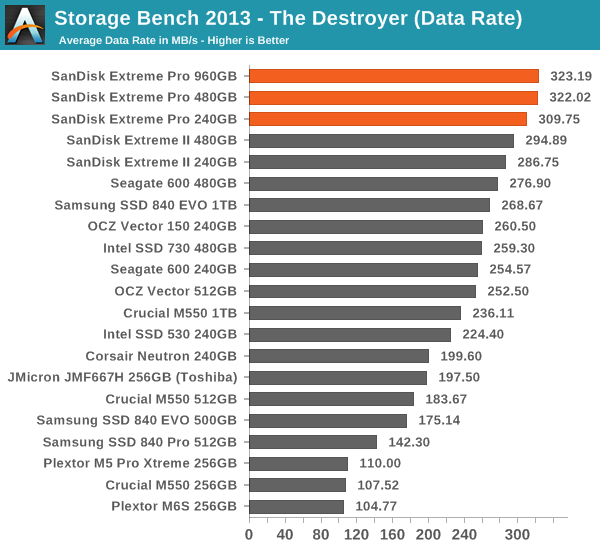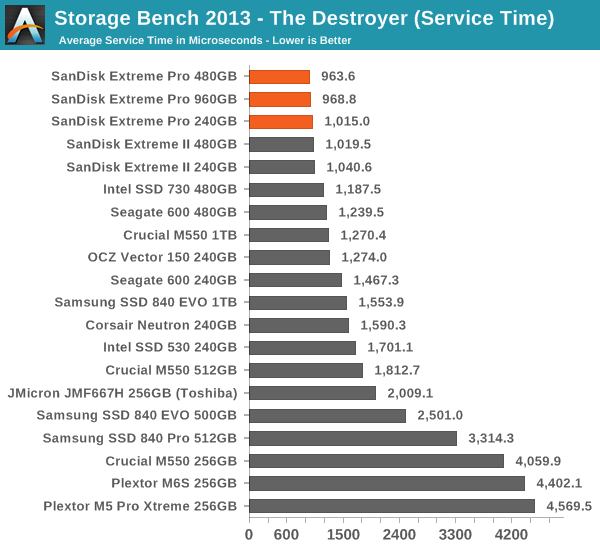SanDisk Extreme Pro SSD (240GB, 480GB & 960GB) Review: The Fastest Just Got Faster
by Kristian Vättö on June 16, 2014 4:00 PM EST- Posted in
- Storage
- SSDs
- SanDisk
- Extreme Pro
AnandTech Storage Bench 2013
Our Storage Bench 2013 focuses on worst-case multitasking and IO consistency. Similar to our earlier Storage Benches, the test is still application trace based - we record all IO requests made to a test system and play them back on the drive we are testing and run statistical analysis on the drive's responses. There are 49.8 million IO operations in total with 1583.0GB of reads and 875.6GB of writes. I'm not including the full description of the test for better readability, so make sure to read our Storage Bench 2013 introduction for the full details.
| AnandTech Storage Bench 2013 - The Destroyer | ||
| Workload | Description | Applications Used |
| Photo Sync/Editing | Import images, edit, export | Adobe Photoshop CS6, Adobe Lightroom 4, Dropbox |
| Gaming | Download/install games, play games | Steam, Deus Ex, Skyrim, Starcraft 2, BioShock Infinite |
| Virtualization | Run/manage VM, use general apps inside VM | VirtualBox |
| General Productivity | Browse the web, manage local email, copy files, encrypt/decrypt files, backup system, download content, virus/malware scan | Chrome, IE10, Outlook, Windows 8, AxCrypt, uTorrent, AdAware |
| Video Playback | Copy and watch movies | Windows 8 |
| Application Development | Compile projects, check out code, download code samples | Visual Studio 2012 |
We are reporting two primary metrics with the Destroyer: average data rate in MB/s and average service time in microseconds. The former gives you an idea of the throughput of the drive during the time that it was running the test workload. This can be a very good indication of overall performance. What average data rate doesn't do a good job of is taking into account response time of very bursty (read: high queue depth) IO. By reporting average service time we heavily weigh latency for queued IOs. You'll note that this is a metric we have been reporting in our enterprise benchmarks for a while now. With the client tests maturing, the time was right for a little convergence.

Given that the Extreme II was already dominating the Storage Bench 2013, it doesn't come as a surprise that the Extreme Pro is the new crownholder. Even the SSD 730 and Vector 150 can't challenge the Extreme Pro despite the fact that in terms of pure random write performance they are better. I think SanDisk's strength lies in mixed read/write performance because write performance alone does not yield good results in real world workloads, which tend to be a mix of reads and writes.
In fact, client workloads (like our Storage Benches) are usually more read-centric anyway and in the case of the Extreme Pro, the drive spent over three times longer processing read IOs than write IOs, which makes sense because there are nearly four times more read IOs than there are write IOs in the trace (even though in terms of gigabytes the difference is only twofold).











85 Comments
View All Comments
LtGoonRush - Monday, June 16, 2014 - link
The only improvements are idle power consumption and support for Low-Power DDR3, and this isn't really a mobile-targeted drive.Oyster - Monday, June 16, 2014 - link
10 years warranty. Love it. L.O.V.E. I.T. Thank you, SanDisk, for setting this trend. I'll surely wait, but I think this is exactly what I need for my next build.10 years... OMFG! Drool!
tential - Monday, June 16, 2014 - link
It's a great warranty but I think ssds potential failure points are less than an hdd. (my speculation).When I saw that though it definitely peaked my interest. Would have purchased this drive if it had been an option as that warranty would definitely make me feel better as I hold onto my hardware for a long time.
MrSpadge - Tuesday, June 17, 2014 - link
I'd still choose the MX100 over this any day. It's not like these drives are falling apart everywhere. And if you save the price difference between these drives you could use it to buy something significantly better in a few years, should the MX100 have failed by then (I wouldn't expect it to).nathanddrews - Tuesday, June 17, 2014 - link
This is pretty awesome:http://techreport.com/review/26523/the-ssd-enduran...
havefunbob - Tuesday, June 17, 2014 - link
that is really good testbinarycrusader - Monday, June 16, 2014 - link
How exactly is this a no compromise drive when it doesn't offer encryption and it doesn't offer capaciyor-based power loss protection? Data integrity and security seem like pretty big compromises. Or is the SLC buffer seen as a sufficient substitute for a capacitor-based solution?BillyONeal - Monday, June 16, 2014 - link
It is a no compromise drive for the market it targets -- the consumer market. Few / no consumer-targeted drives have capacitors; pretty much all such drives are targeting the server market, such as Intel's SSD DC3700. Very few consumer drives offer TCG Opal, but some do, e.g. Samsung's 840 EVO.binarycrusader - Monday, June 16, 2014 - link
The author specifically mentioned disappointment at the lack of encryption, and the author, unlike you specifically used the phrase "only no compromise high-end SSD in the market" while simultaneously declaring Intel's 730 SSD, OCZ's Vector 150, and Samsung 840 Pro as being in that same "high-end" market. So it seemed rightfully bizarre to simultaneously proclaim it as a "no compromises" drive given the other drives the author also compared it to that are supposedly in the same market.Also, while you're right that few consumer-targeted drives have capacitors, the Crucial M500 does. And honestly, capacitors don't cost that much, but it's no wonder Intel's happy to let all of the other manufacturers fight over "razor-thin" margins.
Kristian Vättö - Tuesday, June 17, 2014 - link
Because the Extreme Pro is the only high-end SSD without the compromises that the three other SSDs have. Intel SSD 730 and OCZ Vector 150 don't support any form of low-power states and are thus not suitable for laptops. The 840 Pro, on the other hand, lacks IO consistency. All three drives are in the same high-end performance market, thus I'm comparing the Extreme Pro with them.Crucial's drives have capacitors that provide power loss protection but they are the only drives along with Intel's SSD 730. However, you can get away without capacitors if the firmware is designed not to rely too much on the DRAM cache. I would certainly like to see OEMs use capacitors more in consumer-grade drives but on the other hand, I'm not sure if I consider it to be that big of a deal. We don't have a proper way to test power losses, so I don't want to give too much value to a feature that may or may not be needed.